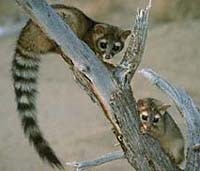Ring-tailed cat
| Ringtail | |
|---|---|
 |
|
| Scientific classification | |
| Kingdom: | Animalia |
| Phylum: | Chordata |
| Class: | Mammalia |
| Order: | Carnivora |
| Family: | Procyonidae |
| Genus: | Bassariscus |
| Species: | B. astutus |
| Binomial name | |
|
Bassariscus astutus (Lichtenstein, 1830) |
|
| Subspecies | |
|
|
 |
|
| Ring-tailed cat range | |
The ringtail (Bassariscus astutus) is a mammal of the raccoon family, native to arid regions of North America. It is also known as the ringtail cat, ring-tailed cat, miner's cat or bassarisk, and is also sometimes called a "civet cat" (after similar, though unrelated, cat-like omnivores of Asia and Africa). The ringtail is sometimes called a cacomistle, though this term seems to be more often used to refer to Bassariscus sumichrasti.
The ringtail is buff to dark brown in color with white underparts and a black and white "ringed" tail that has 14–16 white and black stripes, which is longer than the rest of its body. The claws are short, straight, and semi-retractable. The eyes are large and black, each surrounded by a patch of light fur. It is smaller than a house cat and is one of the smallest extant procyonids (only the smallest in the olingo species group average smaller). It measures 30–42 cm (12–17 in) long to the base of the tail with the tail adding another 31–44 cm (12–17 in). It can weigh from 0.7 to 1.5 kg (1.5 to 3.3 lb). Ringtails have occasionally been hunted for their pelts, but the fur is not especially valuable.
Typically weighing around three pounds, ringtails possess superb hearing and eyes that allow them to move about at night. A nocturnal creature, the ringtail's large eyes and upright ears make it easier for it to move about in the dark. Its fur ranges in coloring from tawny to grayish, and a pointed muzzle with long whiskers resembles that of a fox - which is appropriate in that its very name means ‘clever little fox’. Its tail is about a foot long, with seven to nine black rings and is about the same length as the animal's body. Like its namesake, the ringtail uses this tail for balancing when moving about its habitat. The tail also serves another purpose, acting as a distraction for potential predators. The white rings provide predators with a focus other than the ringtail itself; by grabbing the tail rather than the body, the ringtail has a greater chance of escaping. Additionally, their semi-retractable claws and long tail provide the ringtail with tools ideal for climbing.
In areas with a bountiful source of water, as many as 50 ringtails/sq. mile have been found. Ranging from 50 to 100 acres, the territories of male ringtails occasionally intersect with several females It has been suggested that ringtails utilize feces as a way to mark territory. In 2003, a study done in Mexico City found that ringtails tended to defecate in similar areas in a seemingly nonrandom pattern, mimicking that of other carnivores that utilized excretions to mark territories. Ringtails prefer a solitary existence but may share a den or be found mutually grooming one another. They exhibit limited interaction except during the breeding season, which occurs in the early spring. Occasional prey to coatis, foxes, coyotes, bobcats, lynxes, and mountain lions, the ringtail is rather adept at avoiding predators. Its ability to excrete musk when startled or threatened is largely attributed to the ringtail’s success in deterring potential predators. The main predators of the ringtail are the Great Horned Owl and the Red-tailed Hawk.
...
Wikipedia

